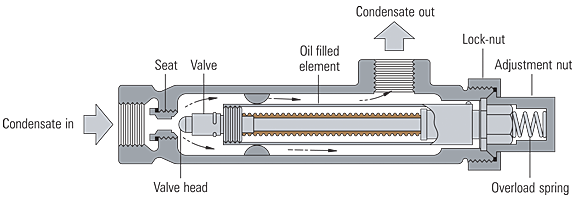 |
| Liquid expansion steam trap |
This is one of the simplest thermostatic traps and is shown in Figure 1 An oil filled element expands when heated to close the valve against the seat. The adjustment allows the temperature of the trap discharge to be altered between 60°C and 100°C, which makes it ideally suited as a device to get rid of large quantities of air and
cold condensate at start-up.
 |
| FIG:-1 Liquid expansion steam trap |
 |
| FIG:- 2 Response of a liquid expansion steam trap |
The temperature of saturated steam varies with pressure. Figure 2 shows the saturation curve for steam, together with the fixed temperature response line (X - X) of the liquid expansion trap, set at 90°C.
It can be seen from Figure 2 that when the pressure is at pressure P1, condensate would have to cool by only a small amount (DT 1), and trapping would be acceptable. However, if pressure is increased to P2 then condensate has to cool more ((DT 2) to pass through the steam trap. This cooling can only occur in the pipe between the process and trap, and if the trap discharge temperature remains constant, the process will waterlog.
Typical application:-
Because of its fixed temperature discharge characteristic, the liquid expansion trap may be usefully employed as a 'shutdown drain trap'. Here, its outlet must always point upwards, as illustrated in Figure 3, to enable continuous immersion of the oil filled element. As the trap can only discharge between 60°C - 100°C it will only normally open during start-up. It can be installed alongside a mains drain trap which would normally be piped to a condensate return line.
 |
FIG:- 3 Installation of a liquid expansion steam trap |
Advantages of the liquid expansion steam trap:-
1.Liquid expansion traps can be adjusted to discharge at low temperatures, giving an excellent 'cold drain' facility.
2.Like the balanced pressure trap, the liquid expansion trap is fully open when cold, giving good air discharge and maximum condensate capacity on 'start-up' loads.
3.The liquid expansion trap can be used as a start-up drain trap on low pressure superheated steam mains where a long cooling leg is guaranteed to flood with cooler condensate. It is able to withstand vibration and waterhammer conditions.
Disadvantages of the liquid expansion steam trap:-
1.The flexible tubing of the element can be destroyed by corrosive condensate or superheat.
2.Since the liquid expansion trap discharges condensate at a temperature of 100°C or below, it should never be used on applications which demand immediate removal of condensate from the steam space.
3.If the trap is to be subjected to freezing conditions the trap and its associated pipework must be well insulated.

No comments:
Post a Comment